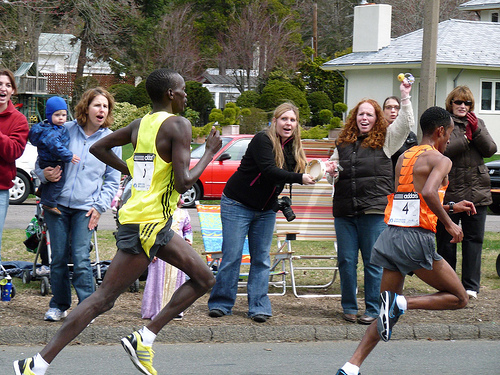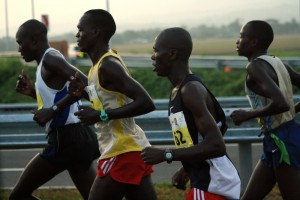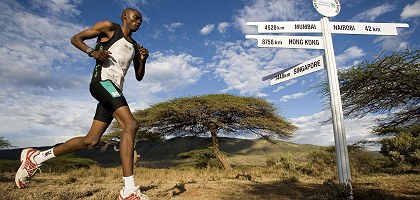Training Secrets of Elite Kenyan Runners.
By Raymond Onyango.
The year 2011 has proven to be a record year of sorts for Kenya’s top marathon runners. Even with the untimely death of our great Olympic Marathon Champion, the late Samuel Wanjiru; Kenya’s marathon runners have still managed to break the world record courtesy of Patrick Makau, who recently shattered Haile Gabreselasie’s previous record at the Berlin marathon. Even more revealing is the fact that as at this moment, Kenyans occupy no less than 25 of the top 30 positions in the world marathon rankings. This year alone we’ve won all six of the major World Marathon Majors, including – Boston, London, New York marathons, not to mention the hitherto elusive World Championship marathon Gold in Daegu Korea, where we promptly swept up all the medals on offer in both the men’s and women’s marathon races.
But what is it that makes Kenyans such great long distance runners? And what can the rest of us mere mortals learn from these elite runners about how to run better, safer and faster?
Run Barefoot or Jump Rope
It has been argued often, and rather controversially so; that many of Kenya’s greatest marathon runners were inadvertently launched into their careers out of the sheer necessity of running several miles everyday, often barefoot just to make it to and from school. Whether or not this is actually true, is a moot point, but it does not negate the fact that human beings are actually designed to run barefoot and have mostly done so for millennia i.e until the advent of the modern running shoes. One of the things you will very quickly discover about running barefoot, if take the trouble to try it for yourself; is that it forces you to land very lightly on the balls of your feet rather than much more heavily on your heels. This fact is what makes it such a saviour for your joints, in terms of minimizing impact and therefore injury!
When I first started out in my career as a fresh faced rookie fitness instructor about 15 years ago, one of the people who mentored me and took the time to teach me valuable lessons about keeping fit and running in particular was none other than Douglas Wakiihuri, the 1987 world marathon champion in Rome and a silver medalist at the Seoul Olympics the following year.
It was Douglas Wakiihuri, who first taught me how to skip consistently to the rhythm of music – an activity he would indulge in for hour after hour in the gym, stopping only to crank out a set of pull-ups here and there.
Skipping as it turns out is one of the best activities you can do to help your running, precisely because skipping, just like running barefoot, is all about how you land on your feet.
Your legs are actually designed by nature to be excellent shock absorbers. When you are jumping rope and you land lightly on the balls of your feet, all of that force travels via the bridge of your foot, through your achilles tendon and up your calves into your hamstrings, quadriceps, and ultimately your hips, where it is again released back down the other leg as the kinetic energy which powers your very next step. This allows you to stay light on your feet, incurring relatively little impact on the body, a fact which will improve both your running speed and reduce your potential for injury.
By contrast when you hit the ground heel first, that force is transmitted straight up into your knees concentrated in your lower back and other weight bearing joints with rather painful and many a times disastrous results, such as shin splints, worn out knee cartilage, torn menisci or displaced vertebral discs – all of which are avoidable injuries, but ones that far too many runners are never the less all too familiar with!
Control Your Fall
Once you have learned to run silently on the balls of your feet, it is time to incorporate another very important concept in running – The Controlled Fall. One of biggest mistakes made by many novice and experienced runners alike, is to increase their stride length in a bid to go faster, but this actually often produces the exact opposite effect.
When you watch some of the world’s elite marathon runners, such as the Kenyan greats pictured here above, you will be immediately struck by one thing – the turn over rate of their feet. One study that examined several of the world’s best athletes over the marathon distance concluded that the majority of them take an average of 180 steps every minute! The reason behind this is that taking smaller steps allows them to place their feet right below, or other wise behind their body’s natural center of gravity, which lies three or four finger widths below the navel.
Why is this important?
Your body has 3 main weights, the head, the chest and the hips all of which are stacked one above the other. When you attempt to run with a very drawn out stride length which essentially places your feet ahead of any of these weights, your immediately incur a very significant breaking action with each and every step. This absolutely unnecessary breaking action not only wastes energy, it also compounds the direct impact on your joints ultimately leading to injury.
By contrast, learning run while leaning forward just to the point where you begin to feel like you are falling forward, allows you to initiate movement using nothing but the force of gravity alone. This saves you tons on energy and allows you to focus on maintaining turnover at the feet rather than literally throwing your entire body-weight around!
The second part of the equation lies in learning to take smaller quicker steps. You can do this by visualizing the ground as a bed or smoldering coals so hot, you can barely let your feet touch its surface. This will force you to focus on quickly lifting up your feet from the ground as soon as they touch down. You will now have the force of gravity doing the work for you as you move forwards, with your stride opening up behind you and your heels flicking up towards your buttocks, making for a very low impact running technique that will increase your speed and endurance while helping to keep you free of injury.
Run Like A Kenyan
- The further you lean forward the more speed you will get. Your lean is literally your speed.
- Keep your stride short. Your foot should always land below your body, never ahead of it. Remember that the longer your stride the greater the impact on your joints.
- Land on the balls of your feet. This transmits minimum shock to your joints and allows you to draw on gravity for propulsion
- Keep your feet moving. Elite athletes take about 180 steps per minute; this reduces the amount of time you spend on the ground and therefore you loose less momentum.
- Focus on picking your legs up when running rather than pushing off the feet as many of us do. Your major running muscles are actually your hip flexors and extensors, not your legs
- Keep your whole body relaxed to help you save energy.








